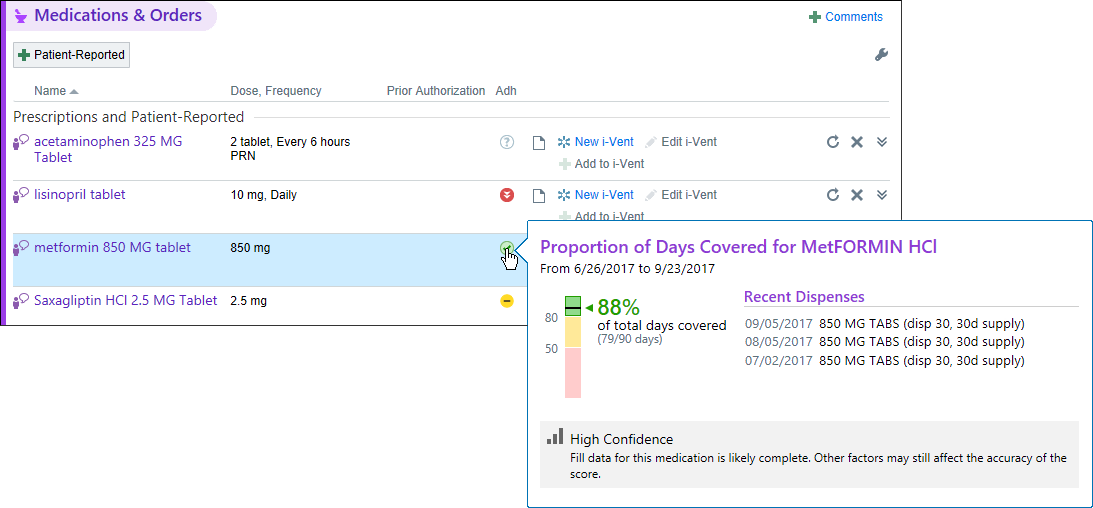Medication Adherence Scoring
Beginning Wednesday, January 23, clinicians will be able to see which patients have been picking up their medications as prescribed with medication adherence ratings. A medication's adherence rating is calculated at the simple generic level and appears in the "Medication & Orders" section during an encounter so clinicians can see, at the point of care, if patients are picking up their medications. A confidence score indicates how reliable the adherence calculation is based on the availability of information such as dispense history and claims data.
For example, imagine Beth, a middle-aged patient with type 2 diabetes, arrives at your clinic for her yearly physical exam and you, as her physician, want to know how her current medication therapy is working for her:
- Beth checks in for her appointment at the front desk, which triggers an eligibility query for her benefits and medication history.
- The system automatically calculates a medication adherence score and confidence score using the medication history data, in addition to dispenses received from Willow Ambulatory and available pharmacy claims data.
- You open the encounter for Beth's office visit and view her current medications in the "Medications & Orders" section. You see that lisinopril has a low adherence rating, but it looks like she has been refilling her metformin and saxagliptin regularly.
- You decide to ask Beth about any side effects she's experienced, and you find out that she experienced dizziness and headaches when taking lisinopril. You then work with Beth to find a medication therapy that works best for her.

How it Works:
How is Medication Adherence Determined?
Medication adherence is determined by comparing a patient's current outpatient medication list in Epic with the number of times a medication has been dispensed. For example, imagine a patient's PCP writes a prescription for three months' worth of metformin and lisinopril. The patient starts taking both medications, but stops taking the lisinopril after one month because of the side effects. By default, the system calculates the medication adherence scores over a period of three months based on how long the current prescriptions of metformin and lisinopril have been active. So, if you expected the patient to fill both prescriptions three times within three months, the adherence score would be roughly 100% and 33%, respectively, if the patient filled both prescriptions on the day they were prescribed.
The start and end dates used in the calculation vary depending on the lookback period you use and the time of the last medication history query. Clinicians can view the time period used in the calculation in the hover bubble and the Meds Adherence Details report. If the patient is admitted during the lookback period, the dates of the admission are excluded from the adherence calculation.
The medication adherence score also accounts for times when the dispense history in Epic isn't up-to-date. For example, the dispense history in Epic can run several months behind if you import pharmacy claims data from payers and you don't receive the claims until several months after the medication is dispensed. In addition, when you view a patient's medication adherence information outside of a face-to-face encounter, the dispense history might be up-to-date as of the last eligibility query that occurs when you Retrieve Patient Benefit Information for a Visit, which might be days or months ago.
The start and end dates used for the calculation are adjusted to account for this delay. For example, if the system ran an eligibility query three months ago and there are no other sources of dispense information, the end date of the calculation period shifts back three months so the adherence score is not negatively affected by the lack of dispenses during that time period.
How Does the Confidence Score Work?
The confidence score is calculated based on the reliability of the source data and is broken into three levels:
- High confidence. If patients get all of their prescriptions from a pharmacy that reports dispense data, the system assigns a higher confidence score. The system also assigns a higher confidence score if the adherence score is over 85%, indicating reliable data.
- Medium confidence. If a patient's dispense history doesn't meet all of the criteria for a high confidence score, but claims data is available, the system assigns a medium confidence score. Claims data typically includes all dispenses, but does not cover dispenses if patients pay for medications out of pocket or choose to use different insurance.
- Low confidence. If not all prescriptions for the same medication are dispensed by pharmacies that send dispense data, and no claims data is available, the system assigns a low confidence score to account for possible gaps in the dispense history.
How is Adherence Calculated for Sample, OTC, and PRN Medications?
To accurately calculate a score when clinicians give patients sample medications, you can specify which medication class counts as samples. Then, when a clinician orders a sample medication with the class you specify, that sample is considered completely dispensed in the medication adherence calculation for the associated prescription. Inpatient sample medications are never included in medication adherence scoring.
Medication adherence scores aren't calculated for over-the-counter medications or medications taken as needed.


